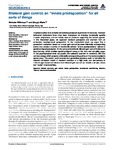Bilateral gain control; an “innate predisposition” for all sorts of things
| dc.contributor.author | Wilkinson, N | |
| dc.contributor.author | Metta, G | |
| dc.date.accessioned | 2017-06-23T15:46:28Z | |
| dc.date.available | 2017-06-23T15:46:28Z | |
| dc.date.issued | 2014 | |
| dc.identifier.issn | 1662-5218 | |
| dc.identifier.issn | 1662-5218 | |
| dc.identifier.other | ARTN 9 | |
| dc.identifier.uri | http://hdl.handle.net/10026.1/9538 | |
| dc.description.abstract |
Empirical studies have revealed remarkable perceptual organization in neonates. Newborn behavioral distinctions have often been interpreted as implying functionally specific modular adaptations, and are widely cited as evidence supporting the nativist agenda. In this theoretical paper, we approach newborn perception and attention from an embodied, developmental perspective. At the mechanistic level, we argue that a generative mechanism based on mutual gain control between bilaterally corresponding points may underly a number of functionally defined "innate predispositions" related to spatial-configural perception. At the computational level, bilateral gain control implements beamforming, which enables spatial-configural tuning at the front end sampling stage. At the psychophysical level, we predict that selective attention in newborns will favor contrast energy which projects to bilaterally corresponding points on the neonate subject's sensor array. The current work extends and generalizes previous work to formalize the bilateral correlation model of newborn attention at a high level, and demonstrate in minimal agent-based simulations how bilateral gain control can enable a simple, robust and "social" attentional bias. | |
| dc.format.extent | 16-30 | |
| dc.format.medium | Electronic-eCollection | |
| dc.language | eng | |
| dc.language.iso | eng | |
| dc.publisher | Frontiers Media SA | |
| dc.subject | bilateral symmetry | |
| dc.subject | gain control | |
| dc.subject | innate predisposition | |
| dc.subject | embodiment | |
| dc.subject | beamforming | |
| dc.subject | attention | |
| dc.subject | "like me" | |
| dc.subject | human-robot interaction | |
| dc.title | Bilateral gain control; an “innate predisposition” for all sorts of things | |
| dc.type | journal-article | |
| dc.type | Article | |
| plymouth.author-url | https://www.ncbi.nlm.nih.gov/pubmed/24611045 | |
| plymouth.issue | FEB | |
| plymouth.volume | 8 | |
| plymouth.publication-status | Published online | |
| plymouth.journal | Frontiers in Neurorobotics | |
| dc.identifier.doi | 10.3389/fnbot.2014.00009 | |
| plymouth.organisational-group | /Plymouth | |
| plymouth.organisational-group | /Plymouth/Faculty of Science and Engineering | |
| plymouth.organisational-group | /Plymouth/REF 2021 Researchers by UoA | |
| plymouth.organisational-group | /Plymouth/REF 2021 Researchers by UoA/UoA11 Computer Science and Informatics | |
| dc.publisher.place | Switzerland | |
| dcterms.dateAccepted | 2014-02-05 | |
| dc.identifier.eissn | 1662-5218 | |
| dc.rights.embargoperiod | Not known | |
| rioxxterms.versionofrecord | 10.3389/fnbot.2014.00009 | |
| rioxxterms.licenseref.uri | http://www.rioxx.net/licenses/all-rights-reserved | |
| rioxxterms.licenseref.startdate | 2014 | |
| rioxxterms.type | Journal Article/Review |


